Jaipur Limb
 The Rotary Club of Belfast has previously supported Rotary Jaipur Limb who help to give a positive life back to the many who are unable to walk.
The Rotary Club of Belfast has previously supported Rotary Jaipur Limb who help to give a positive life back to the many who are unable to walk.
The Rotary Jaipur Limb Project (RJLP) is a pro-active fund-raising and project-initiating body of Rotarians, drawn from all over RIBI. It was formed in 1985 (becoming a registered charity in 1995).
The Jaipur Limb is an artificial leg, developed at the Mahaveer hospital in Jaipur, India.
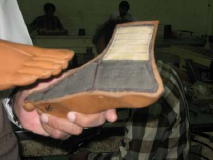 The unique component is the Jaipur foot, a clever combination of wood and various densities of rubber vulcanised into a realistic looking brown foot. It is hard-wearing and will last for three or four years, longer if worn with a shoe.
The unique component is the Jaipur foot, a clever combination of wood and various densities of rubber vulcanised into a realistic looking brown foot. It is hard-wearing and will last for three or four years, longer if worn with a shoe.
One of the major differences between the Jaipur technology and western technology is the cost - whereas a western limb will cost between £1,500.00, a Jaipur limb can be made and fitted for as little as £25.00.
There are 12 trustees, assisted by several co-opted managers, who divide their time between raising awareness of the project among Rotarians in RIBI, identifying appropriate sites for projects, principally in India and Africa, and assisting in the preparation of programmes, budgets and financing for those projects.
The bulk of their work in India revolves around Limb camps, with as many as 3000 patients turning up for help, but in Africa and other countries outside India they establish new permanent centres and provide on-going support for them by way of technician training, materials and equipment.
Following the earthquake in Haiti in January 2010, 5,000 victims, many of them emergency "chainsaw amputees", required artificial limbs. To these amputees hope and expectation was often no more than a metal crutch.
To help, RJLP built in 2010/11 a limb camp consisting of a workshop and consulting area at the Bienfaisance Hospital in Pignon, together with a new Orthopaedic Training School, including demonstration/classroom, trainee accommodation and trainer's quarters. Initially funded from the RIBI Haiti Appeal augmented by funds from Districts 1110 & 1250, funding was also required to provide equipment, materials and staff training. Rotary Ireland District financed, at a cost of £32,000, an off-road 4x4 all terrain vehicle to transport the amputees to and from the Hospital unit, especially from the more remote areas.
The Club was pleased to support this project with funding to leave a specialized vehicle in the name of Rotary in Ireland doing essential work helping the people of Haiti.
Visit to Jaipur Limb Centre
Club Past President Marnette Lyons, when in India for Polio Vaccination Day in 2009, had the opportunity to visit the Limb Centre in Jaipur and was highly impressed. She reported as follows:
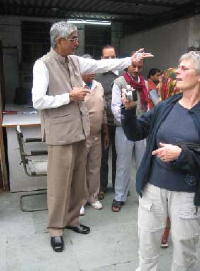 "A few years after becoming a Rotarian I attended a District Meeting at which Past District Governor Gussie Hynes, trustee of Rotary Jaipur Limb Trust Project, made a presentation on the Project and passed around a Jaipur Limb. It was a very moving presentation and one which I am sure all who were present still remember. Recently, while in Northern India to participate in the National Polio Immunization, I had the opportunity to go to Jaipur following the immunization work.
"A few years after becoming a Rotarian I attended a District Meeting at which Past District Governor Gussie Hynes, trustee of Rotary Jaipur Limb Trust Project, made a presentation on the Project and passed around a Jaipur Limb. It was a very moving presentation and one which I am sure all who were present still remember. Recently, while in Northern India to participate in the National Polio Immunization, I had the opportunity to go to Jaipur following the immunization work.
A tour had been organised for us in Jaipur and much to my disappointment it did not include the Jaipur Centre (Bhagwan Mahaveer Viklang Sahayata Samiti). However, a visit to the Limb Centre was my priority and five others in my group were also keen to see it. After asking directions from some locals and looking at maps we had a general idea where the Limb Centre was located and so we set out to find it. Eventually, we reached a small building off the main thoroughfare. On arrival we noticed people sitting on benches and on the ground waiting.
Meanwhile a tall distinguished looking gentleman, who was busy checking reports, immediately spotted and greeted us with a warm smile and the words, "You must be Rotarians".
Introductions soon made us aware that the gentleman was D.R.Mehta the founder and chief patron of Jaipur Foot. Following a car accident in which he broke several bones in his leg and faced the possible prospect of amputation Mr Mehta, whose profession was in law and administration, became aware of the plight of millions of poor people unable to cope with life and in need of prosthetic limbs. He observed the degrading way in which these poor, starving and desperate people, crippled or without limbs, were treated and he knew it must change.
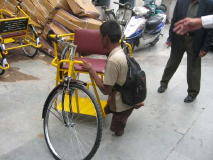 The small centre where we had arrived was not the main Limb Centre but appeared to be a remote annex where patients who could not have artificial limbs, were brought. Mr Mehta invited us to join him while he greeted each patient with a smile, asked them their name, and let them tell him something about themselves. It was apparent that these patients, who were extremely poor, had travelled from all parts of India insearch of help to give them a better life. The polio victims who crawled on all fours were given special hand pedal tricycles and it was amazing how in an instant they became mobile and gained human dignity.
The small centre where we had arrived was not the main Limb Centre but appeared to be a remote annex where patients who could not have artificial limbs, were brought. Mr Mehta invited us to join him while he greeted each patient with a smile, asked them their name, and let them tell him something about themselves. It was apparent that these patients, who were extremely poor, had travelled from all parts of India insearch of help to give them a better life. The polio victims who crawled on all fours were given special hand pedal tricycles and it was amazing how in an instant they became mobile and gained human dignity.
 Sitting outside under a tree were some more patients and Mr Metha spoke gently to each one, listened to their plight and then advised them how they were going to be helped. Confirmation of this help was written on a piece of paper and handed to the patient. One sad woman with club feet told him that she had 3 sisters and her mother had died; she couldn't work but could sew. Mr Mehta told her that before the end of the day she would have special shoes and a sewing machine. This simple act was like sprinkling her with magic dust, her face and posture immediately changed; she would no longer be considered "worthless" in her community for soon she would be able to return to her village to earn a living. The image of her smiling face is bound to stay with me for ever. This was far from what I had expected when I set out to find the Centre and nothing could have prepared me for the emotional experience of shadowing Mr Metha while he met patients; it was well outside my comfort zone.
Sitting outside under a tree were some more patients and Mr Metha spoke gently to each one, listened to their plight and then advised them how they were going to be helped. Confirmation of this help was written on a piece of paper and handed to the patient. One sad woman with club feet told him that she had 3 sisters and her mother had died; she couldn't work but could sew. Mr Mehta told her that before the end of the day she would have special shoes and a sewing machine. This simple act was like sprinkling her with magic dust, her face and posture immediately changed; she would no longer be considered "worthless" in her community for soon she would be able to return to her village to earn a living. The image of her smiling face is bound to stay with me for ever. This was far from what I had expected when I set out to find the Centre and nothing could have prepared me for the emotional experience of shadowing Mr Metha while he met patients; it was well outside my comfort zone.
After Mr Mehta had personally spoken to every patient, we travelled with him a few miles across town to the Jaipur Centre, by now I certainly had no idea what to expect. We were told that most patients arrive unannounced, starved and penniless with nowhere to stay. Every patient is treated with dignity and is registered upon arrival no matter what time of day or night. Patients are provided with food, assessed, treated and given accommodation while their limb is being made. The entire service is provided free.
 Upon our arrival we immediately went through to the production section and it was nothing like the factory that I had envisage. Natural light streamed in through large windows which lined one side of the room. It had a lovely warm and very friendly atmosphere and to my surprise several of the workers were former patients. Close to the entrance was a young man propped up against a wall he had only one leg. His worn out artificial limb was removed and cling film was wrapped around his pelvis in readiness for a technician to make a cast. Mr Metha explained that the man had no hip and pointed out the wear and tear on the old limb.
Upon our arrival we immediately went through to the production section and it was nothing like the factory that I had envisage. Natural light streamed in through large windows which lined one side of the room. It had a lovely warm and very friendly atmosphere and to my surprise several of the workers were former patients. Close to the entrance was a young man propped up against a wall he had only one leg. His worn out artificial limb was removed and cling film was wrapped around his pelvis in readiness for a technician to make a cast. Mr Metha explained that the man had no hip and pointed out the wear and tear on the old limb.
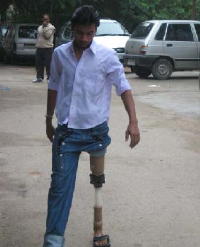 As we saw limbs being made I could not help notice that some of the patients were sitting watching their limbs being made, this certainly reinforced the consideration given to patients. MeanwhileMr Mehta explained that expensive western-style artificial limbs are unsuitable for use in India. This is because westerners sit on chairs while Indians squat and sit cross-legged on the ground. People in rural India do not wear shoes and they also walk on much rougher ground and often through dirt and water.
As we saw limbs being made I could not help notice that some of the patients were sitting watching their limbs being made, this certainly reinforced the consideration given to patients. MeanwhileMr Mehta explained that expensive western-style artificial limbs are unsuitable for use in India. This is because westerners sit on chairs while Indians squat and sit cross-legged on the ground. People in rural India do not wear shoes and they also walk on much rougher ground and often through dirt and water.
We watched how a cast is taken from the patients stump. Following this a technician lifted a length of high density polyethylene brown drainage pipe. This was heated and then moulded to the cast and the excess trimmed at the top. All of this was performed by two technicians very quickly while the polyethylene was still pliable.
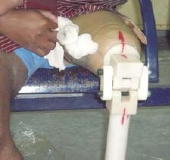 Once the limb is made the foot is attached.
Once the limb is made the foot is attached.
It was apparent that Mr Metha was very excited by the production of a new computer designed, four bar link-aged, knee joint developed in association with Stanford University in California. This inexpensive joint to produce improves freedom of movement and does not lock. It was amazing to see how well patients wearing a limb with this new joint could walk, run and even ride a bicycle.
We visited the treatment area for polio victims and it was encouraging that there were no patients to be treated. Mr Mehta told us that there had not been any new recent cases of young children requiring treatment. After leaving the production and treatment rooms we visited the reception area where patients were waiting to be seen. The room was bright and the walls were covered with murals of symbols from many different religions. As he pointed out each one, Mr Metha emphasised that the centre is independent from government, non-religious, non-regional and an apolitical society. It aims to help the physically challenged, about 99% of whom live below the poverty line.
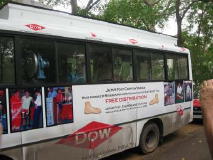 Outside we saw new accommodation under construction and then visited a fully fitted out mobile unit. We were informed that the Centre has held Jaipur Foot fitment camps not only in India but also in several other countries such as Afghanistan, Bangladesh, Nepal, Pakistan and Sudan. Earlier in the week, we visited a small centre in the basement of the Rotary Club of Bareilly South building which is run by the Rotary Club.
Outside we saw new accommodation under construction and then visited a fully fitted out mobile unit. We were informed that the Centre has held Jaipur Foot fitment camps not only in India but also in several other countries such as Afghanistan, Bangladesh, Nepal, Pakistan and Sudan. Earlier in the week, we visited a small centre in the basement of the Rotary Club of Bareilly South building which is run by the Rotary Club.
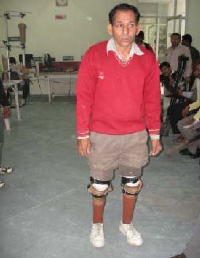 Since founding the Centre in Jaipur in 1975, over 1 million people have had their lives transformed by giving them mobility, self respect and human dignity. Many have had 2 limbs added as the picture right.
Since founding the Centre in Jaipur in 1975, over 1 million people have had their lives transformed by giving them mobility, self respect and human dignity. Many have had 2 limbs added as the picture right.
What impressed me was the kindness and consideration patients receive and the holistic approach to solving their predicament. The physical, social and economic well being of all patients is taken into consideration. They leave mobile and those with no economic support are given a sewing machine, tea stall set or other appropriate tools so that they can earn a living and support themselves.
By coincidence, while I was there, my neighbour also made her first visit to India as part of a group from Tearfund. When passing through Delhi an amputee beggar on crutches knocked on her window seeking money. Her driver informed her that he had no excuse to be in this situation and explained to her about the Jaipur Limb Centre where an amputee can have an artificial limb fitted free. This was her introduction to the Jaipur Limb Project.
In 2010 Rotary Jaipur Limb Project will celebrate its silver anniversary and Mr Mehta told us that he would be making a presentation at the next RIBI conference in Bournemouth. This will be a truly wonderful opportunity to hear an exceptionable gentleman tell you a remarkable story".
